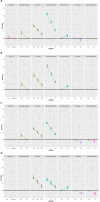Febrile neutropenia prophylaxis, G-CSF physician preferences: discrete-choice experiment
- PMID: 34706865
- PMCID: PMC11672075
- DOI: 10.1136/bmjspcare-2021-003082
Febrile neutropenia prophylaxis, G-CSF physician preferences: discrete-choice experiment
Abstract
Objectives: Febrile neutropenia (FN) commonly occurs during cancer chemotherapy. Prophylaxis with granulocyte colony-stimulating factors (G-CSFs) is known to reduce the severity and incidence of FN and infections in patients with cancer. Despite the proven efficacy, G-CSFs are not always prescribed as recommended. We performed a discrete-choice experiment (DCE) to determine what factors drive the physician preference for FN prophylaxis in patients with cancer undergoing chemotherapy.
Methods: Attributes for the DCE were selected based on literature search and on expert focus group discussions and comprised pain at the injection site, presence of bone pain, associated fever/influenza syndrome, efficacy of prophylaxis, biosimilar availability, number of injections per chemotherapy cycle and cost. Oncologists, in a national database, were solicited to participate in an online DCE. The study collected the responses to the choice scenarios, the oncologist characteristics and their usual prescriptions of G-CSFs in the context of breast, lungs and gastrointestinal cancers.
Results: Overall, the responses from 205 physicians were analysed. The physicians were mainly male (61%), with ≤20 years of experience (76%) and working only in public hospitals (73%). The physicians prescribe G-CSF primary prophylaxis for 32% of patients: filgrastim in 46% and pegfilgrastim in 54%. The choice of G-CSF for primary and secondary prophylaxis was driven by cost and number of injections. Biosimilars were well accepted.
Conclusion: Cost and convenience of G-CSF drive the physician decision to prescribe or not G-CSF for primary and secondary FN prophylaxes. It is important that these results be incorporated in the optimisation of G-CSF prescription in the clinical setting.
Keywords: cancer; hospital care; supportive care; symptoms and symptom management.
© Author(s) (or their employer(s)) 2022. Re-use permitted under CC BY-NC. No commercial re-use. See rights and permissions. Published by BMJ.
Conflict of interest statement
Competing interests: FS benefited from assistance from Amgen, Roche, Pierre Fabre, Léo Pharma, Pfizer, BMS, Mylan, Vifor Pharma, Helsinn Healthcare, Mundipharma and MSD. HS benefited from assistance from Lilly, Pfizer, Tesaro, Novartis, Lilly, Vifor Pharma, Pierre Fabre, Mundipharma, Mylan, Sandoz, Roche and AstraZeneca. PL was a board member for Servier, Roche, Sanofi, Janssen, Ipsen, Pierre Fabre, Pfizer, Lilly, Novartis, Bristol Myers Squibb and MSD; received funding for congresses from Pierre Fabre, Pfizer and Novartis; and received funding for his institution from Lilly, Amgen, Roche and Merck Serono. E-CA benefited from assistance from AstraZeneca, Novartis, Pfizer, MSD, Lilly, Eisai and Pierre Fabre. KG was employed by Mundipharma. CC received fees for attending scientific meetings, coordinating research or consulting from AstraZeneca, Boehringer Ingelheim, GlaxoSmithKline, Roche, Sanofi Aventis, Bristol Myers Squibb, MSD, Lilly, Novartis, Janssen, Bayer, Mundipharma and Amgen.
Figures


References
-
- Gatzemeier U, Ciuleanu T, Dediu M, et al. XM02, the first biosimilar G-CSF, is safe and effective in reducing the duration of severe neutropenia and incidence of febrile neutropenia in patients with small cell or non-small cell lung cancer receiving platinum-based chemotherapy. J Thorac Oncol. 2009;4:736–40. doi: 10.1097/JTO.0b013e3181a52964. - DOI - PubMed
-
- MacDonald K, McBride A, Alrawashdh N, et al. Cost-efficiency and expanded access of prophylaxis for chemotherapy-induced (febrile) neutropenia: economic simulation analysis for the US of conversion from reference pegfilgrastim to biosimilar pegfilgrastim-cbqv. J Med Econ. 2020;23:1466–76. doi: 10.1080/13696998.2020.1833339. - DOI - PubMed
LinkOut - more resources
Full Text Sources
Miscellaneous
